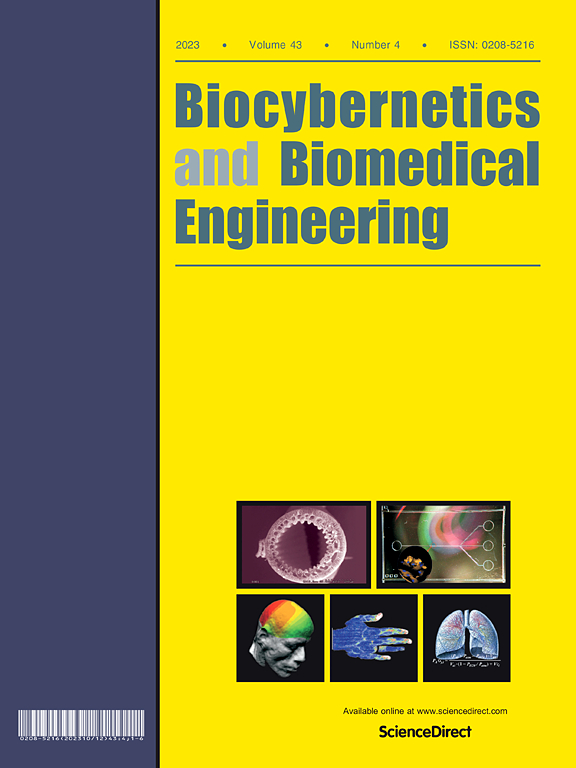深度时空特征优化融合与协调注意机制在脑电下肢运动前意向解码中的应用
IF 6.6
2区 医学
Q1 ENGINEERING, BIOMEDICAL
引用次数: 0
摘要
背景与目的运动前意图的解码是开发神经康复机器人系统脑机接口的关键。然而,由于脑电信号的微弱幅度和非平滑特性,现有的方法无法达到正确应用的精度。本研究提出了一种新的运动前意图解码网络框架,通过提取和优化脑电信号的深层时空特征来提高解码准确率。方法基于大脑意图产生机制及其运动表达,构建深度时空神经网络结构。将采集到的多通道脑电数据重组为脑地形分布,经过特征的初始提取和坐标注意机制的优化,设计了具有两个双向门控循环单元的3层密集块,有效提取深层时空特征,进一步高效解码动作前意图。结果健康受试者和脑卒中幸存者对动作前意向的平均解码准确率分别为95.51±1.79%和90.48±2.90%。各项评价指标均为优秀。伪在线测试显示,健康受试者和脑卒中幸存者的平均TPR分别为95.45±3.80%和90.71±7.77%,潜伏期分别为- 1965±48 ms和- 1974±36 ms。实验结果和对比分析表明,所提出的框架是合理的,其解码能力优于其他最先进的算法。结论该方法在基于脑电信号的运动前意图解码中具有较高的解码精度和良好的在线性能,为进一步的神经康复机器人系统奠定了基础。本文章由计算机程序翻译,如有差异,请以英文原文为准。
Deep spatio-temporal features optimised fusion with coordinate attention mechanism for EEG lower limb pre-movement intention decoding
Background and Objective
Decoding pre-movement intention is crucial in developing a brain-computer interface (BCI) for neuro-rehabilitation robotic systems. However, the weak amplitude and non-smooth characteristics of EEG signals lead to the inability of existing methods to achieve the accuracy for proper applications. This study proposed a novel pre-movement intention decoding network framework to improve accuracy by extracting and optimizing the deep spatio-temporal features of EEG signals.
Methods
A deep spatio-temporal neural network structure was constructed based on the brain intention generation mechanism and its movement expression. The collected multi-channel EEG data were reorganized into brain topographic distributions, after the initial extraction of the features and optimization using the coordinate attention mechanism, a 3-layer dense block with two bi-directional gated recirculation units was designed to effectively extract the deep spatial and temporal features, further decoding the pre-movement intention efficiently.
Results
The experimental results showed an average accuracy of 95.51 ± 1.79 % for healthy subjects and 90.48 ± 2.90 % for stroke survivors in decoding pre-movement intention. All evaluation indexes are excellent. Pseudo-online testing showed the average TPR was 95.45 ± 3.80 % and 90.71 ± 7.77 % for healthy subjects and stroke survivors, respectively, and the latency was −1965 ± 48 ms and −1974 ± 36 ms. The results of the ablation and comparative analysis showed that the proposed framework is justified and its decoding capability outperforms other state-of-the-art algorithms.
Conclusion
The method proposed in this study has high decoding accuracy and good online performance in pre-movement intention decoding based on EEG signals, which lays the foundation for further neuro-rehabilitation robotic systems.
求助全文
通过发布文献求助,成功后即可免费获取论文全文。
去求助
来源期刊

Biocybernetics and Biomedical Engineering
ENGINEERING, BIOMEDICAL-
CiteScore
16.50
自引率
6.20%
发文量
77
审稿时长
38 days
期刊介绍:
Biocybernetics and Biomedical Engineering is a quarterly journal, founded in 1981, devoted to publishing the results of original, innovative and creative research investigations in the field of Biocybernetics and biomedical engineering, which bridges mathematical, physical, chemical and engineering methods and technology to analyse physiological processes in living organisms as well as to develop methods, devices and systems used in biology and medicine, mainly in medical diagnosis, monitoring systems and therapy. The Journal''s mission is to advance scientific discovery into new or improved standards of care, and promotion a wide-ranging exchange between science and its application to humans.
 求助内容:
求助内容: 应助结果提醒方式:
应助结果提醒方式:


